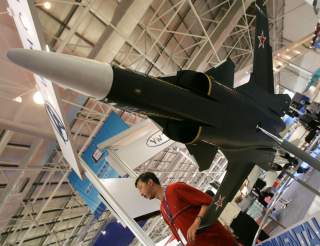Why the Su-47 Fighter Failed (But Still Helped Russia's Air Force)
Learn from your mistakes.
Key Point: If at first, you don't succeed, try, try again. That was the lesson Moscow took from its Su-47.
At the Zhukovsky International Airport outside Moscow, Russia, MAKS 2019 air show attendees were treated to a rare piece of Russian military aviation history: the Su-47, a fascinating but flawed testbed for cutting-edge 1990’s fighter technology.
Not seen since MAKS 2007, the Su-47 Berkut (“Golden Eagle”) was put on static display as part of a coterie of experimental Russian aircraft to be shown at Zhukovsky Airport. the Aviationist’s Tom Demerly captured footage of the Su-47 being hauled to its designated display site, while Russian media provided additional closeups of the fighter.
Conceived in 1983 as a sweeping modernization program for Russia’s prolific Su-27 air superiority fighter, the “Su-37”-- as it was known before being renamed in the following decade-- was an exercise in ambitious aircraft design.
Berkut’s main attraction is its unorthodox forward-swept wings, a feature it shares with only one other known aircraft, the US Grumman X-29.
The core idea is ingeniously simple: On a rear-swept configuration, air naturally moves from the wing root to the wingtip. Sukhoi technicians theorized that funneling air from the wingtip to the wing root--that is, inverting the wings-- would lead to extreme gains in maneuverability, enable a shorter minimum takeoff and landing distance, and provide significant performance advantages in dogfights at high angles of attack. Additionally, relocating the wing spar to was thought to create more internal space.
However, Berkut’s design proved too forward-looking for its own good. Subsequent testing, both in the US and USSR, found that reversing the wing root and tip leads to insurmountable technical issues that are not worth the dubious performance gains. Forward swept wings are prone to extreme, and frequently unrecoverable stall instability, not to mention potential wing failure from an excessive degree of aeroelastic twisting. Parallel advancements in thrust-vectoring technology, which reproduced many of the maneuverability gains of forward-swept wings but without the stability risks, made it even harder to justify Berkut’s core design.
An early prototype model was displayed at MAKS 1999; by then, Berkut’s aerodynamic shortcomings were too glaring to ignore. By the time of its next appearance at MAKS 2001, Berkut was renamed as the Su-47 and transformed into an experimental testbed for Russian fighter technology. Despite its failure to enter serial production, the Su-47 went on to become the “flying laboratory” for several of the aerodynamic design principles and features that made it onto Russia’s flagship Su-57 fifth-generation fighter. The Su-47 not only housed the prototypes of what became the Su-57’s internal weapons bay, but also featured an early rendition of the digitized avionics systems used by the latter. Additionally, the Su-47’s later incorporation of thrust vectoring provided Sukhoi engineers with performance data that was used to refine thrust vectoring on other Sukhoi aircraft including the Su-57.
The Su-47’s unexpected appearance was, to many, a pleasant distraction from the central motif of MAKS 2019: the unveiling of the Su-57 export version, and it’s a subsequent demonstration to Turkish leader Recep Tayyip Erdoğan. But there is, perhaps, a more salient factor at play-- 36 years after its ill-fated introduction, the Su-47 serves as a powerful reminder of the many twists and turns on Russia’s long road to a serially-produced fifth-generation fighter.
Mark Episkopos is a frequent contributor to The National Interest and serves as research assistant at the Center for the National Interest. Mark is also a PhD student in History at American University. This first appeared earlier in 2019. Image: Reuters

